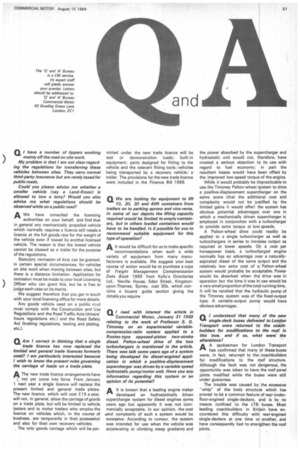0 . 1 read with interest the article in
Page 59

If you've noticed an error in this article please click here to report it so we can fix it.
Commercial Motor, January 31 1969 relating to the work of Professor S. G. Timoney on an experimental variablecompression-ratio system applied to a Root es-type opposed-piston two-stroke diesel. Pefton-wheel drive of the two turbochargers is mentioned in the article. There was talk some years ago of a system being developed for diesel-engined application in which a positive-displacement supercharger was driven by a variable-speed hydrostatic pump/motor unit. Have you any information regarding this system or an opinion of its potential?
Ait is known that a leading engine maker
developed an hydrostatically driven supercharger system for diesel engines some years ago but apparently it was not commercially acceptable. In our opinion, the cost ..and complexity of such a system would be excessive. According to rumour, the system was intended for use when the vehicle was accelerating or climbing steep gradients and the power absorbed by the supercharger and hydrostatic unit would not, therefore, have created a serious objection to its use with regard to fuel economy; in part the resultant losses would have been offset by the improved low-speed torque of the engine.
While it would probably be impracticable to use the Timoney Felton-wheel system to drive a positive-displacement supercharger on the same score (that the additional cost and complexity would not be justified by the limited gains it would offer) the system has obvious potential advantages over one in which a mechanically driven supercharger is employed in conjunction with a turbocharger to provide extra torque at low speeds.
A Pelton-wheel drive could readily be applied to a single turbocharger as well as turbochargers in series to increase output as required at lower speeds. On a cost per horsepower basis, a turbocharged engine normally has an advantage over a naturallyaspirated diesel of the same output and the relatively low extra cost of a Pelton-wheel system would probably be acceptable. Power would be absorbed when the drive was in operation but the time it was in use would be a very small proportion of the total running time. It will be recalled that the hydraulic pump of the Timoney system was of the fixed-output type. A variable-output pump would have obvious advantages.






































































































